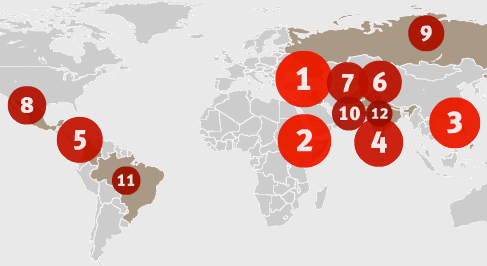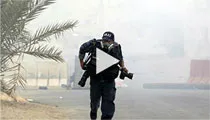Violence plagued journalists in northeastern Assam, Manipur, and Arunachal Pradesh, including four attacks on the Arunachal Times. Tongam Rina, a columnist for the paper, survived a shooting that put her in intensive care for a time. The authorities blocked hundreds of websites they claimed incited ethnic and religious protests in Assam and beyond, but the blocking also affected numerous online news outlets, along with sites that were rebutting calls for violence. The September arrest of anti-graft cartoonist Aseem Trivedi on sedition, insult, and other charges outraged civil society. Trivedi made bail as the sedition charge was dropped, but at least two freelance journalists facing anti-state charges remained in jail without trial for more than a year. A third reporter was imprisoned in late year on retaliatory charges filed after he exposed assaults on young women in Karnataka state. India placed 12th on CPJ’s Impunity Index of countries that fail to solve journalist murders. A botched inquiry into the 2011 killing of Jyotirmoy Dey was seen as emblematic of the failure. In Uttar Pradesh, Karnataka, and Maharashtra, assailants obstructed coverage of politics, courts, and religion. Nationwide, coverage of corruption was risky: Rajesh Mishra was slain in March for reporting on financial irregularities in Madyha Pradesh schools. In May, Jharkhand authorities threatened videographer Mukesh Rajak for asking questions about local expenditures. Twenty-five percent of journalists killed in India since 1992 covered corruption.
India
» Amid Northeast unrest, journalists are attacked and websites blocked.
» The authorities use antiquated sedition laws to silence critical journalists.
Violence plagued journalists in northeastern Assam, Manipur, and Arunachal Pradesh, including four attacks on the Arunachal Times. Tongam Rina, a columnist for the paper, survived a shooting that put her in intensive care for a time. The authorities blocked hundreds of websites they claimed incited ethnic and religious protests in Assam and beyond, but the blocking also affected numerous online news outlets, along with sites that were rebutting calls for violence. The September arrest of anti-graft cartoonist Aseem Trivedi on sedition, insult, and other charges outraged civil society. Trivedi made bail as the sedition charge was dropped, but at least two freelance journalists facing anti-state charges remained in jail without trial for more than a year. A third reporter was imprisoned in late year on retaliatory charges filed after he exposed assaults on young women in Karnataka state. India placed 12th on CPJ’s Impunity Index of countries that fail to solve journalist murders. A botched inquiry into the 2011 killing of Jyotirmoy Dey was seen as emblematic of the failure. In Uttar Pradesh, Karnataka, and Maharashtra, assailants obstructed coverage of politics, courts, and religion. Nationwide, coverage of corruption was risky: Rajesh Mishra was slain in March for reporting on financial irregularities in Madyha Pradesh schools. In May, Jharkhand authorities threatened videographer Mukesh Rajak for asking questions about local expenditures. Twenty-five percent of journalists killed in India since 1992 covered corruption.
-
12th
Impunity Index ranking -
400,000
Northeasterners displaced -
142
Year-Old Sedition Law -
300
Websites blocked
India ranks among the world's worst in combating deadly anti-press crime, according to CPJ's Impunity Index, which calculates unsolved journalist murders as a percentage of each country's population. At least six journalist murders have gone unsolved in India in the past decade.

| 1. Iraq 2. Somalia 3. Philippines 4. Sri Lanka | 5. Colombia 6. Nepal 7. Afghanistan 8. Mexico | 9. Russia 10. Pakistan 11. Brazil 12. India |
Fatal July riots in Assam's Kokrajhar District sprang from tensions between Muslims and Bodo tribes. As civilians fled in large numbers, the press came under fire.
1 | Prominent editor, Ahongsangbam Mobi, attacked in insurgent-ridden Manipur in 2012. |
3 | Maharashtra journalists attacked in 2012 for perceived failures to cover violence against Muslims in Assam. |
4 | Unsolved attacks at the Arunachal Times offices, carried out within six months in 2012. |
3 | Assamese journalists killed for their work since 1992. They include Mohammed Muslimuddin, Prahlad Goala, and Parag Kumar Das. |
The penal code's notorious Section 124 (A), introduced by the British in 1870 to quell rebellion, is still used to silence critical journalists. Cartoonist Trivedi is among at least four journalists who have been targeted under sedition and other anti-state laws since 2009:
79 | Days in prison reporter Laxman Chaudhury of the Oriya-language Sambad daily spent on sedition charges before his release in 2009. |
479 | Days behind bars for Lingaram Kodopi, held on anti-state charges since September 2011. |
699 | Days Sudhir Dhawale has been imprisoned without trial on charges of sedition and terrorism for articles in Vidrohi magazine. |
The government said the sites spread fabricated images of anti-Muslim violence, fanning tensions in the northeast and beyond in August. Critics called the blocks arbitrary and politicized.
22 | Websites carrying "anti-religious" content that a civil court sought to censor. The court issued an order that Google, Facebook, and others remove the pages in response to a Muslim cleric's complaint. |
6 | Twitter accounts blocked by Internet service providers. The accounts had spoofed Prime Minister Manmohan Singh. |
5 | SMS messages permitted per sender, per day, for 15 days in August. The authorities said the rule was intended to limit mass messaging that called for violence, but it also restricted mobile news distribution. |

